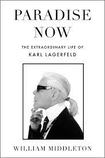
Precocious, patrician and privileged, Karl Lagerfeld will always be remembered as the legendary German fashion designer who transformed the fortunes of Chanel – turning it into one of the world’s most valuable luxury brands. Creative head for more than 30 years, an accomplished illustrator and photographer, he was known as much for his carefully constructed personal style – the powdered pigtail, the stiff white collars, black fingerless gloves and shades – as for his fashion extravaganzas and voracious consumption of contemporary culture.
This so-called definitive new biography is by fashion journalist and author William Middleton, who worked for Women’s Wear Daily in Paris and established “a mutually beneficial relationship” with the designer. It is timely as Lagerfeld is the theme of this year’s Met Gala on May 1st and the Costume Institute’s spring exhibition, A Line of Beauty, which will run until July.
Lagerfeld hated retrospection, detested nostalgia, was famously opinionated and a master at media relations, though occasionally in later life overstepped the mark, particularly with his controversial comments on #MeToo.
Middleton charts the designer’s family background in Hamburg in great detail, revealing how Lagerfeld was interested in style from an early age and how winning a Woolmark Prize in 1954 along with Yves St Laurent jump-started both their careers. He covers the freewheeling 1970s in Paris in which both established their reputations, circles of friends and rivalries.
READ MORE
Middleton describes his milieu of artists, socialites and celebrities focusing on his relationship with the aristocratic young French dandy Jacques de Bascher
Lagerfeld’s output was astonishingly prolific, his lifestyle lavish, his work ethic formidable. Apart from Chanel, he produced more than 100 collections for Fendi, continued designing at Chloe until 1997, was the first to collaborate with H&M, produced costumes for more than 30 films, established his own line as well as furnishing and redesigning the interiors of his many homes and apartments. Middleton describes his milieu of artists, socialites and celebrities focusing on his relationship with the aristocratic young French dandy Jacques de Bascher “the most meaningful of his life” – who later died in his arms of Aids.
Peppered with many anecdotes, the book is an enjoyable read with an amusing chapter on Lagerfeld’s famous cat Choupette and its nanny, but towards the end, the coverage of so many fashion shows, what was shown, who wore what and how Lagerfeld was dressed becomes a little tedious.
There are some surprising omissions: why his own line, later acquired by Tommy Hilfiger, failed to make an impact and his unsuccessful attempts to prevent the publication of The Beautiful Fall by Alicia Drake about the rise of St Laurent and Lagerfeld in the 1970s when, as Paloma Picasso put it, “fashion wasn’t fashionable”.















